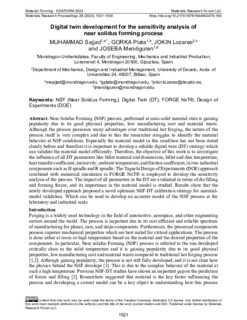| dc.rights.license | Attribution 4.0 International | * |
| dc.contributor.author | Sajjad, Muhammad | |
| dc.contributor.author | Plata, Gorka | |
| dc.contributor.author | Mendiguren, Joseba | |
| dc.contributor.other | Lozares Abasolo, Jokin | |
| dc.date.accessioned | 2024-03-21T10:10:16Z | |
| dc.date.available | 2024-03-21T10:10:16Z | |
| dc.date.issued | 2023 | |
| dc.identifier.issn | 2474-3941 | en |
| dc.identifier.other | https://katalogoa.mondragon.edu/janium-bin/janium_login_opac.pl?find&ficha_no=173016 | en |
| dc.identifier.uri | https://hdl.handle.net/20.500.11984/6300 | |
| dc.description.abstract | Near Solidus Forming (NSF) process, performed at semi-solid material state is gaining popularity due to its good physical properties, low manufacturing cost and material waste. Although the process possesses many advantages over traditional hot forging, the nature of the process itself is very complex and due to this the researcher struggles to identify the material behavior at NSF conditions. Especially the material model in this condition has not been stated clearly before and therefore it is important to develop a reliable digital twin (DT) strategy which can validate the material model efficiently. Therefore, the objective of this work is to investigate the influence of all DT parameters like billet material and dimensions, billet and dies temperature, heat transfer coefficient, emissivity, ambient temperature, and friction coefficient, in two industrial components such as H spindle and R spindle. The Taguchi Design of Experiments (DOE) approach combined with numerical simulation in FORGE NxT® is employed to develop the sensitivity analysis of the process. The impact of all parameters in the DT are evaluated in terms of die filling and forming forces, and its importance in the material model is studied. Results show that the newly developed approach proposed a novel optimum NSF-DT calibration strategy for material-model validation. Which can be used to develop an accurate model of the NSF process at the laboratory and industrial scale. | en |
| dc.language.iso | eng | en |
| dc.publisher | Materials Research Forum LLC | en |
| dc.rights | © 2023 The Authors | en |
| dc.rights.uri | http://creativecommons.org/licenses/by/4.0/ | * |
| dc.subject | Near Solidus Forming (NSF) | en |
| dc.subject | Digital Twin | en |
| dc.subject | FORGE NxT® | en |
| dc.subject | Design of Experiments | en |
| dc.subject | ODS 9 Industria, innovación e infraestructura | |
| dc.subject | ODS 13 Acción por el clima | |
| dc.title | Digital twin development for the sensitivity analysis of near solidus forming process | en |
| dcterms.accessRights | http://purl.org/coar/access_right/c_abf2 | en |
| dcterms.source | Materials Research Proceedings | en |
| local.contributor.group | Procesos avanzados de conformación de materiales | es |
| local.description.peerreviewed | true | en |
| local.description.publicationfirstpage | 1521 | en |
| local.description.publicationlastpage | 1530 | en |
| local.identifier.doi | https://doi.org/10.21741/9781644902479-164 | en |
| local.contributor.otherinstitution | https://ror.org/00ne6sr39 | |
| local.source.details | 2023. Vol. 28. Pp. 1521-1530 | en |
| oaire.format.mimetype | application/pdf | en |
| oaire.file | $DSPACE\assetstore | en |
| oaire.resourceType | http://purl.org/coar/resource_type/c_c94f | en |
| oaire.version | http://purl.org/coar/version/c_970fb48d4fbd8a85 | en |








